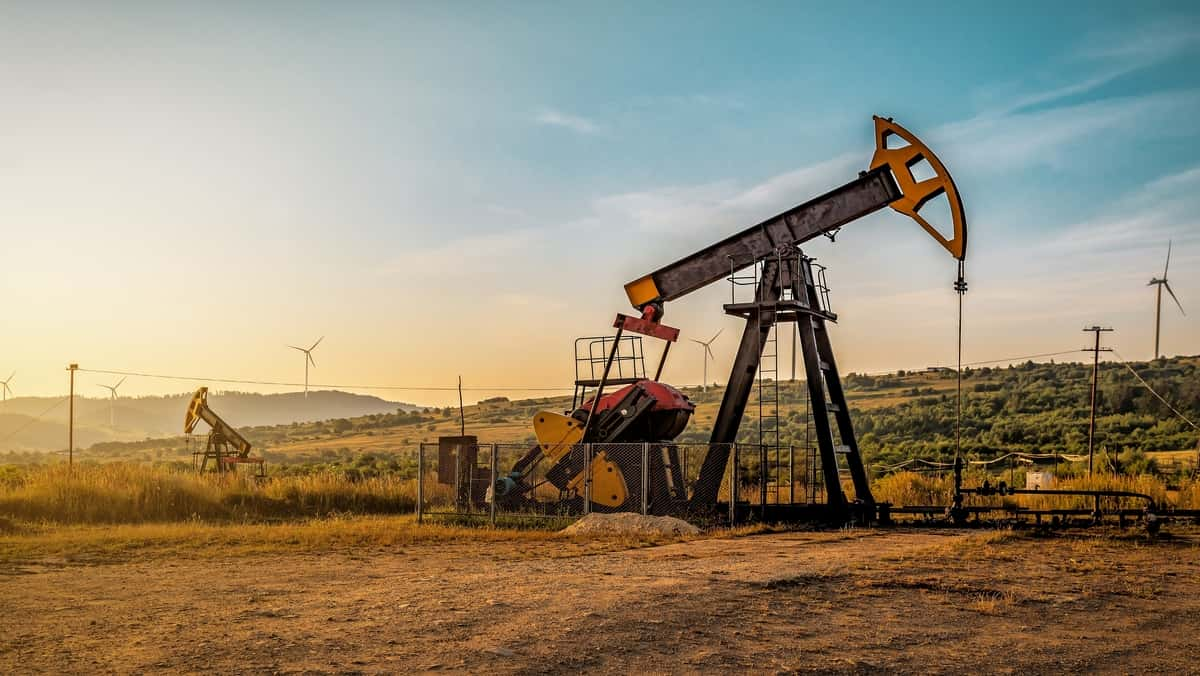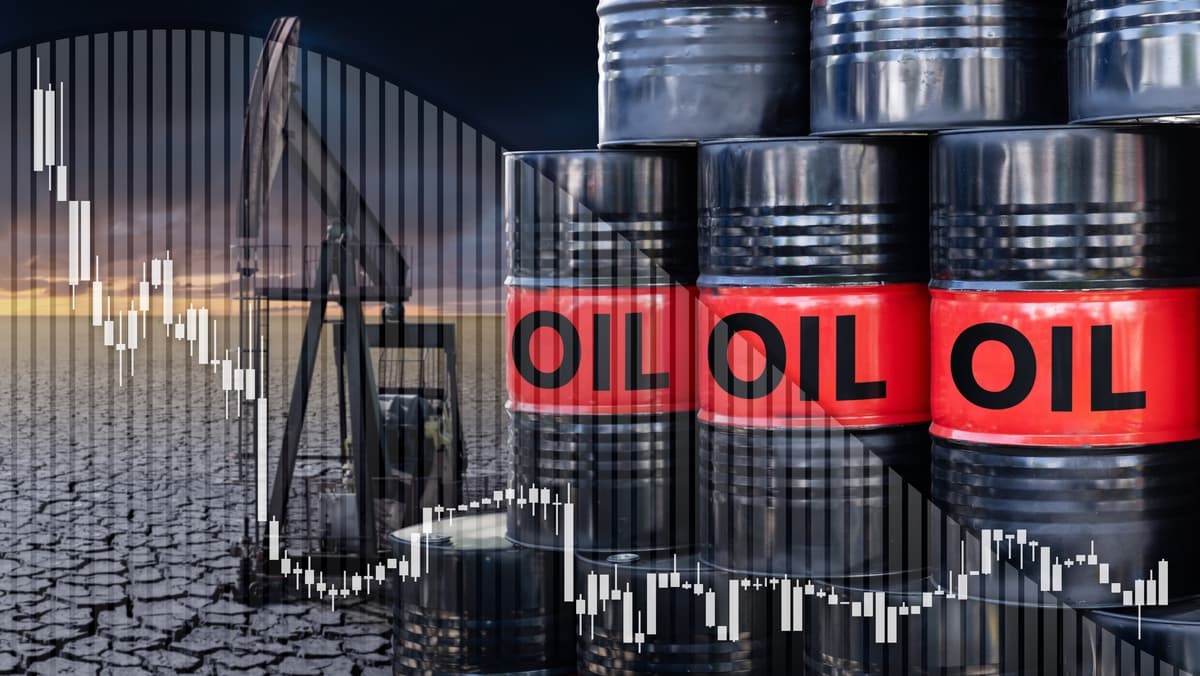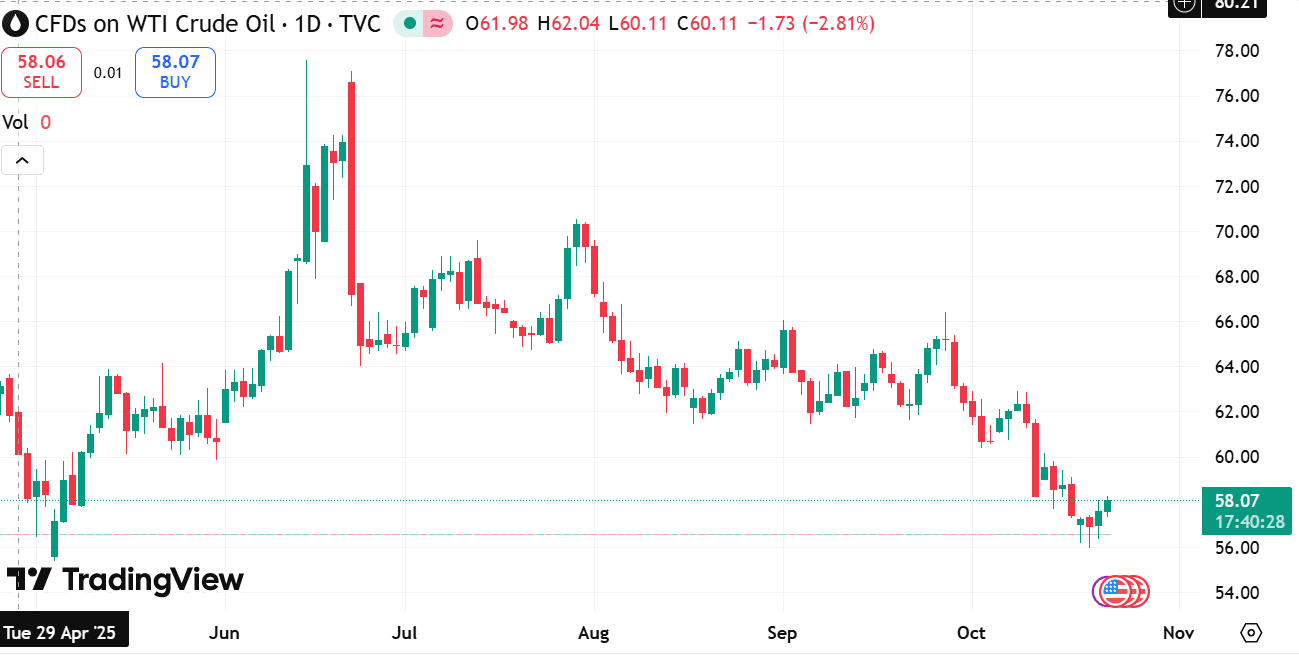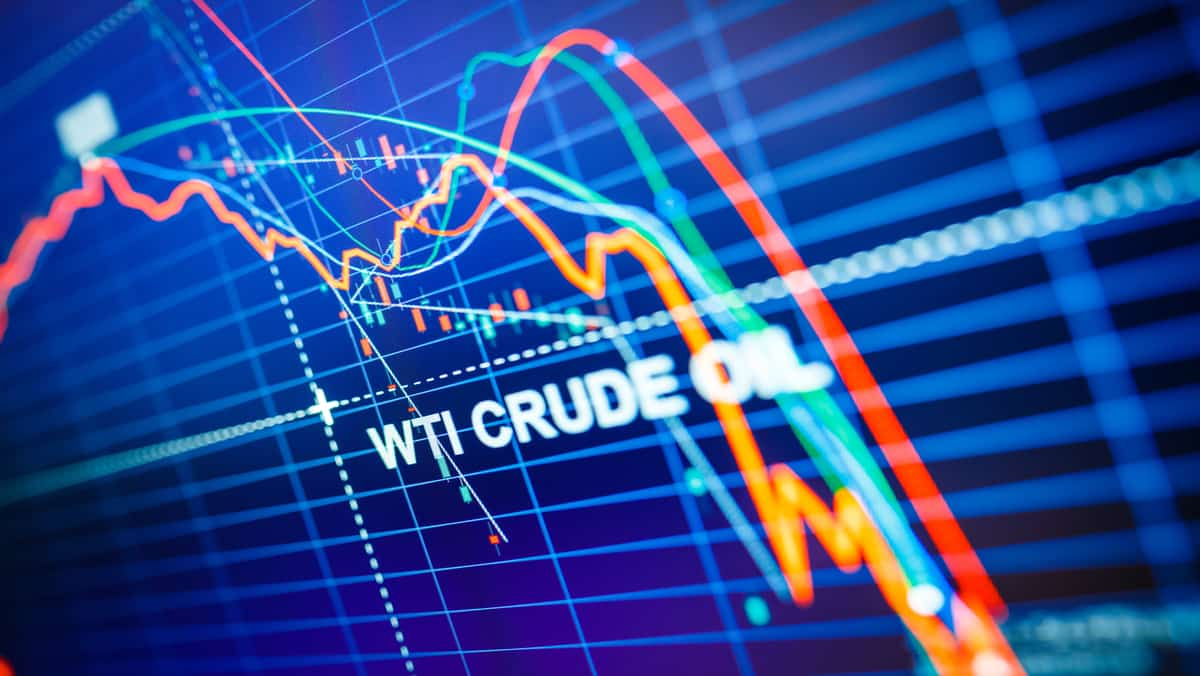
CFD:er är komplexa instrument som innebär hög risk att du förlorar pengar snabbt på grund av hävstången. 72,3% av icke-professionella investerares konton förlorar pengar när de handlar med CFD:er hos den här leverantören. Du bör överväga om du förstår hur CFD:er fungerar och om du har råd att ta den höga risken att förlora dina pengar.
Onsdag Oct 22 2025 03:21

9 min

Commodity market today: Crude oil remains a central commodity that affects transport, industry, and the wider economy.
Traders and holders seek exposure for different reasons: some aim to capture short-term moves, others want to hedge business costs, and some look for portfolio diversification. This guide covers types of crude, historical extremes in price behaviour, key events that shape markets, common ways to gain exposure, why CFDs may suit certain trading styles, risks to consider, indicators to watch, and how future price direction is commonly assessed.
Types of Crude Oil
Crude grades differ by density and sulphur content. Two global benchmarks are commonly referenced: one that reflects light, sweet crude from the US production basin and another that represents a blend used in European and global trade. Lighter crudes with lower sulphur content are generally easier and cheaper to refine into transport fuels, while heavier or sour grades require more complex processing. Regional supply, transport constraints, and refinery demand determine which grades trade at a premium or discount to benchmarks.
Crude Oil Price History
Oil markets have shown wide swings across decades. Prices respond to geopolitical events, production decisions by major exporters, technological shifts in extraction, and changes in demand due to economic cycles or substitutions. Long-term trends have reflected evolving supply sources, such as new production regions and the rise of unconventional extraction techniques, as well as demand shifts tied to industrial growth and energy transitions.

Historical Extremes
Across modern market history, extremes have included both periods of elevated quoted values and episodes where prices turned deeply negative for brief windows under unusual logistical strain. High peaks often arise from tight supply combined with strong demand or acute geopolitical risk. Very low or negative prices have occurred when storage capacity became constrained and market participants faced urgent settlement and delivery difficulties.
The Russia–Saudi Arabia Episode
At times, major producers have adjusted output aggressively in reaction to market pressure or strategic aims. Periods where significant producers both ramped up output while demand was weakening created acute downward pressure, with dramatic moves in quoted levels. Such episodes highlight how production policy and market balance can interact, sometimes producing abrupt re-pricing across global oil markets.
Should You Trade and Hold Crude Oil?
Deciding whether to gain exposure depends on your objectives, timeframe, and tolerance for price swings. Crude oil is cyclical and responds to macroeconomic variables, policy decisions, and logistics constraints. For those focused on short-term price movements, liquid derivative markets offer direct exposure. For those seeking longer-term exposure, company equities or funds that track broad oil-market performance offer alternatives that carry their own trade-offs, such as operational risk and dividend mechanics.

Five Ways to Invest and Trade Crude Oil
Exchange‑Traded Funds (ETFs) that Track Oil
ETFs provide a pathway to oil price exposure without direct futures trading or physical storage. They can track price indices, futures rolls, or baskets that aim to mirror changes in benchmark levels. These funds simplify access via standard trading accounts and may include management fees and roll costs that affect longer-term holdings.
Buy Shares in Oil Companies
Equities of exploration and production firms, refiners, and integrated oil companies deliver exposure to oil through corporate earnings and dividends. Company-specific factors—such as production costs, balance sheets, and project pipelines—drive equity performance alongside general commodity price movements.
Master Limited Partnerships (MLPs) and Energy Infrastructure
Structures that own pipelines, storage, and midstream assets provide exposure to oil flows and fees rather than direct price exposure. These can offer cash distributions and revenue models tied to throughput volumes and service contracts. They are sensitive to regulatory settings and transport demand.

Crude Oil Futures
Futures contracts trade on regulated exchanges and provide direct exposure to benchmark prices for contract months. Futures are used for hedging and speculation and require margin management. Contracts have delivery mechanics, expiration dates, and roll considerations that influence trading outcomes for those who hold positions across settlement cycles.
Contracts for Difference (CFDs) on Oil with Brokers such as markets.com
CFDs replicate the price movement of a given oil benchmark without delivering the physical commodity. They offer access to long or short exposure with margin, and are traded through brokers that provide platforms for execution and risk controls. CFDs remove the logistical burden of handling futures delivery or physical oil, while introducing financing and spread costs.
Why Some Traders Prefer CFDs
CFDs can be appealing for market participants who want pure price exposure without dealing with futures roll mechanics or onshore storage. They permit both buying and selling easily, and margining allows smaller capital outlays to control larger notional exposure. Execution is typically straightforward via web or mobile platforms, and many brokers offer charting and order types to manage entries and exits.
Risks of Trading Crude Oil CFDs
Leverage risk: Margin amplifies both gains and losses. Position size relative to account equity must be managed carefully.
Financing charges: Holding leveraged CFD positions over time incurs financing costs that affect carry for longer-term exposures.
Counterparty and platform risk: CFDs are contractual obligations with the broker rather than ownership of an exchange-traded contract; platform reliability and regulation matter.
Spread and execution risk: During volatile periods, spreads widen and slippage can occur, changing expected trade economics.
Market events and gaps: Sudden geopolitical news or supply shocks can cause rapid price moves beyond stop levels.
Indicators Oil Market Participants Monitor
Market participants watch a combination of supply-side, demand-side, and market-structure indicators:
Predictions and Forward Thinking
Forecasts for future crude levels often integrate a range of inputs: supply plans from producing nations, technical trends in extraction and transport, regulatory and environmental policy paths, and macroeconomic prospects for growth and consumption. Short-term movements may hinge on discrete events—production cuts, outages, or demand shocks—while medium-term trends are shaped by broader shifts such as energy transition, efficiency gains, and changes in transport fuel demand.
Practical Steps for Those Considering Exposure
Clarify timeframe and purpose: Are you trading short-term price moves, hedging exposure, or seeking a longer-term thematic position?
Match the vehicle to the objective: Use futures or CFDs for direct price exposure, equities or ETFs for indirect exposure, and infrastructure securities for flow-based exposure.
Manage position sizing and risk limits: Define how much capital you are willing to allocate and use stops or hedges to protect against rapid downside.
Check regulatory and tax implications: Different products and jurisdictions carry different reporting and tax treatments.
Stay informed on logistics: Bottlenecks, seasonal flows, and storage capacity are practical forces that can drive price moves independent of headline production numbers.

Conclusion
Crude oil markets combine macro drivers, production policy, and real-world logistics. A range of access methods—from ETFs and shares to futures and CFDs—lets participants choose trade-offs between convenience, cost, and exposure. CFDs offered by brokers such as markets.com can simplify access to benchmark price moves, but they bring leverage and counterparty considerations that require careful risk management. Monitoring supply indicators, storage trends, refinery activity, and geopolitical developments helps in forming a view about near-term dynamics, while longer-term direction depends on structural shifts in energy demand and production technology.
Risk Warning and Disclaimer: This article represents only the author’s views and is for reference only. It does not constitute investment advice or financial guidance, nor does it represent the stance of the Markets.com platform. Trading Contracts for Difference (CFDs) involves high leverage and significant risks. Before making any trading decisions, we recommend consulting a professional financial advisor to assess your financial situation and risk tolerance. Any trading decisions based on this article are at your own risk.